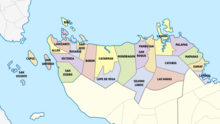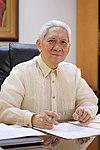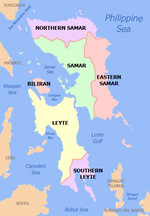| This article needs additional citations for verification. Please help improve this article by adding citations to reliable sources. Unsourced material may be challenged and removed. Find sources: "Northern Samar" – news · newspapers · books · scholar · JSTOR (April 2013) (Learn how and when to remove this message) |
| Northern Samar Hilagang Samar (Filipino) | |
|---|---|
| Province | |
      (from top: left to right) San Bernardino Strait, Dalupiri Island, Church of Bobon, Provincial Capitol, San Vicente Islands, and Capul Lighthouse (from top: left to right) San Bernardino Strait, Dalupiri Island, Church of Bobon, Provincial Capitol, San Vicente Islands, and Capul Lighthouse | |
 Flag Flag Seal Seal | |
 | |
| OpenStreetMap | |
| Coordinates: 12°20′N 124°40′E / 12.33°N 124.67°E / 12.33; 124.67 | |
| Country | Philippines |
| Region | Eastern Visayas |
| Founded | June 19, 1965 |
| Capital and largest municipality | Catarman |
| Government | |
| • Type | Sangguniang Panlalawigan |
| • Governor | Edwin C. Ongchuan (PFP) |
| • Vice Governor | Clarence E. Dato (PFP) |
| • Legislature | Northern Samar Provincial Board |
| Area | |
| • Total | 3,692.93 km (1,425.85 sq mi) |
| • Rank | 34th out of 81 |
| Highest elevation | 514 m (1,686 ft) |
| Population | |
| • Total | 639,186 |
| • Rank | 48th out of 81 |
| • Density | 170/km (450/sq mi) |
| • Rank | 51st out of 81 |
| Divisions | |
| • Independent cities | 0 |
| • Component cities | 0 |
| • Municipalities | 24 |
| • Barangays | 569 |
| • Districts | Legislative districts of Northern Samar |
| Time zone | UTC+8 (PHT) |
| ZIP code | 6400–6423 |
| IDD : area code | +63 (0)55 |
| ISO 3166 code | PH-NSA |
| Spoken languages | |
| Highway routes | |
| Website | northernsamar |
Northern Samar (Waray: Amihanan Samar/Norte san Samar; Tagalog: Hilagang Samar), officially the Province of Northern Samar, is a province in the Philippines located in the Eastern Visayas region. Its capital is Catarman, the most populous town in the province and is located at the northern portion of the island of Samar. Bordering the province to the south are the provinces of Samar and Eastern Samar. To the northwest, across the San Bernardino Strait is Sorsogon; to the east is the Philippine Sea of the Pacific Ocean and to the west is Samar Sea.
History
Further information: Samar (historical province)Spanish colonial era
Historian William Henry Scott wrote that a "Samar datu by the name of Iberein was rowed out to a Spanish vessel anchored in his harbor in 1543 by oarsmen collared in gold; while wearing on his own person earrings and chains." In the local epic called siday entitled Bingi of Lawan as written in the article of Scott, Lawan is a prosperous settlement in Samar.
In 1596, many names, such as Samal, Ibabao, and Tandaya, were given to Samar Island prior to the coming of the Spaniards in 1596. During the early days of Spanish occupation, Samar was under the jurisdiction of Cebu.
In 1614, the Jesuits established a mission residence in Palapag among the Ibabao populace. These missionaries stayed until the late 17th century when they were expelled from the Philippines in 1768 and were replaced by the Franciscans.
As the San Bernardino Strait was along the route of the Spanish galleons plying between Manila and Acapulco, Mexico, a royal port was established in Palapag where the richly laden Manila Galleons were protected from unfavorable winds and troubled seas.
In the early years of the 16th century, shipbuilders were drafted from Palapag to the Cavite shipyards for the construction of galleons and vessels for the conservation of defense of the island. It was also at this time that these recruits ignited the Sumoroy insurrection, which signaled a general uprising against Spain in the Visayas and Mindanao. The insurrection simultaneously flared northward to Albay and southward to the northern coasts of Mindanao and then Cebu. It took over a year before the Spaniards were able to subdue the rebellion.
Samar and Leyte were separated from Cebu in 1735. They were split in 1747 but was reversed in 1762 with the approval of the King of Spain, following complaints from the Jesuits. The province of Samar was later established as a distinct province in 1768 after it got separated from the province of Leyte. In 1777, Samar and Leyte split for the last time when it was approved in Madrid in 1786 and had been effective in 1799.
American invasion era
Later in 1898, when the Americans landed on the beach of Catarman, they organized a revolutionary army led by General Vicente Lukban who fought the invaders armed with cannons and rifles with only bolos and paltiks. Although defeated, they, however, continued to harass the Americans through guerrilla warfare.
Japanese occupation era
During World War II, the people of Northern Samar organized a platoon of volunteers supported by voluntary contributions. The contingent became a part of the Philippine National Guard in Manila. The province also helped the government by purchasing a considerable amount of bonds floated to finance the National Commission for Independence, then organized by Manuel L. Quezon after a coalition of the Nacionalista and Democrata parties were formed.
Philippine independence
Samar Congressmen Eladio T. Balite (1st district), Fernando R. Veloso (2nd district), and Felipe J. Abrigo (3rd district), authored Republic Act No. 4221 which was approved by Congress in 1963. The law, ratified in a plebiscite on June 19, 1965, divided Samar into three: Northern Samar, Eastern Samar and (Western) Samar. The first provincial officials of Northern Samar, aside from the lone district congressman, were elected on November 14, 1967, and on January 1, 1968, they officially assumed office.
Geography

Northern Samar covers a total area of 3,692.93 square kilometers (1,425.85 sq mi) occupying the northern section of Samar Island in the Eastern Visayas region. The province is bounded by north by the San Bernardino Strait, on the east by the Pacific Ocean, on the west by the Samar Sea, on the southwest by Samar and on the southeast by Eastern Samar. It ranks thirty-seventh (37th) in size among the 80 provinces of the Philippines and accounts for practically 1.2 percent of the total land area of the country. About 52 percent of the total land area is covered by forest, while 42 percent is classified as alienable and disposable.
The province is composed largely of low and extremely rugged hills and small lowland areas. It also has small and discontinuous areas along the coasts and its rivers are usually accompanied by alluvial plains and valleys. The province is endowed with relatively rich and fertile soil that most crops can grow on it.
Topography
Northern Samar has a very rugged terrain with restricted pocket plains and valleys. River valleys are low-lying and are often interrupted by hills, while the remaining portion is rolling, hilly, and mountainous. The interior of the mainland consists of highly dissected hills and mountain peaks. Low-lying hills are found between the coastal plains of Palapag, the river valley of Gamay, and Catubig Valley. There are lagoons and lakes (Cinco Forest), and falls near Catubig named Pinipisikan (citation tourism) too.
Climate
Northern Samar falls under the intermediate type climate, which has no distinct dry and wet seasons. The rainiest months are October to January, while the driest is the month of May.
Administrative divisions

Northern Samar is divided into three major geographical areas, namely: Balicuatro area, Central area, and Pacific area including Catubig Valley – the province's rice granary. It comprises 24 towns or municipalities with 569 registered barangays. The province is divided into two legislative districts, the first district, covering the Balicuatro and most part of the Central Area, and the second district, covering the some part of the Central Area, the Pacific Area and the Catubig Valley.
† Provincial capital
Demographics
| Year | Pop. | ±% p.a. |
|---|---|---|
| 1903 | 67,680 | — |
| 1918 | 93,559 | +2.18% |
| 1939 | 155,050 | +2.43% |
| 1948 | 227,957 | +4.38% |
| 1960 | 261,424 | +1.15% |
| 1970 | 306,114 | +1.59% |
| 1975 | 354,665 | +3.00% |
| 1980 | 378,516 | +1.31% |
| 1990 | 383,654 | +0.13% |
| 1995 | 454,195 | +3.21% |
| 2000 | 500,639 | +2.11% |
| 2007 | 549,759 | +1.30% |
| 2010 | 589,013 | +2.54% |
| 2015 | 632,379 | +1.36% |
| 2020 | 639,186 | +0.21% |
| Source: Philippine Statistics Authority | ||
The population of Northern Samar in the 2020 census was 639,186 people, with a density of 170 inhabitants per square kilometer or 440 inhabitants per square mile.
The people of Northern Samar were previously called Ibabaonon. They are predominantly Waray-Waray or Waray, the people of Eastern Visayas or Samar-Leyte region. To distinguish themselves from the Westehanon (people from Samar) and Estehanon (from Eastern Samar) when Samar Island was split into three provinces in 1965, and the Leyteños (the people from the Leyte Island), they now call themselves as Ninorte Samarenyo or Nortehanon. They are primarily speaking in Waray-Waray which is the main lingua franca of the province.
Bicolano and Masbateño inhabitants coming from respective neighboring provinces of Sorsogon and Masbate are also common at Northern Samar.
Languages
| Languages Spoken (2000) | ||||
|---|---|---|---|---|
| Language | Speakers | |||
| Waray | 632,379 | |||
| Cebuano | 14,436 | |||
| Abaknon | 10,668 | |||
| Binisaya | 8,885 | |||
| Tagalog | 746 | |||
| Others | 3,306 | |||
| Not Reported | 1,571 | |||
The majority of the people in the province speak the Ninorte Samarnon variation of Waray-Waray. About 4.5 percent of the population, especially in the island towns, speak Cebuano, particularly in the island town of San Antonio. Inabaknon, a unique language said to be one of the most preserved languages to date, is the native tongue of the populace in the island town of Capul.
Ninorte Samarnon usually is further subclassified into Balicuatro, Central and Pacific speakers.
Tagalog and English are also widely used and understood in Northern Samar.
Religion
Main article: Religion in the PhilippinesCatholicism
The communities of this province are predominantly Catholic (80%).
Others
Other religious groups are Members Church of God International (MCGI), Iglesia ni Cristo, Philippine Independent Church (Iglesia Filipina Independiente), Seventh-day Adventists, Jehovah's Witnesses, The Church of Jesus Christ of Latter-day Saints and other Christian sects. A small number of population are Muslim.
Socio-demographic situation
Northern Samar is classified as a second class province, according to the Philippine Statistics Authority, the data gathered from the Department of Finance Department Order No.23-08 (Effective July 29, 2008).
Catarman is the capital town of the province where most political and economic activities take place. It is the seat of administration and the center of trade and commerce as well as industry.
The province is considered a very rural area with 65% of its people residing in the countryside.
Economy
Poverty incidence of Northern Samar
|
10
20
30
40
50
60
70
2006 53.41 2009 52.10 2012 50.19 2015 60.25 2018 34.26 2021 19.30 Source: Philippine Statistics Authority |
Tourism
Northern Samar has several tourism potentials that remain undiscovered by tourists. Some of these include old churches, waterfalls, rivers, caves, virgin forests, and beaches.
Among the last frontiers in the country, its rugged coastline of limestone cliffs along the Pacific Ocean is a historical landmark. During the Spanish colonial era, Samar island was the first Philippine landfall seen by the Manila galleons as they approached the end of their long voyage from Acapulco.
Entering the waters of the Philippine archipelago, the galleons called at the fortified island of Capul off Samar, offered thanks for a safe crossing at the Jesuit church, and then negotiated the rough waters of the narrow San Bernardino Strait toward Manila, their final destination.
Capul also became the last stop on Philippine soil of the departing galleons before the long, often treacherous trans-Pacific voyage to Acapulco in Mexico.
Government

Governor
- Edwin C. Ongchuan (NUP)
Vice Governor
- Clarence E. Dato (NUP)
Congressional districts
List of former governors
- Irene Balite (1967–1971)
- Edilberto A. del Valle (1971–1980)
- Reynaldo A. del Valle (1980–1986)
- Justiniano M. Singzon (1986–1988)
- Harlin Abayon (1988–1998)
- Madeleine M. Ong (1998–2001)
- Raul A. Daza (2001–2010)
- Paul R. Daza (2010–2013)
- Jose L. Ong, Jr. (2013–2019)
Official provincial seal

The Coat of Arms of Samar represents the political, geographical description, historical, economic, and social representation and allegorical ideas of the province. The letters N and S represent Northern Samar. The map of Northern Samar represents the geography and 24 municipalities of the province, including the five island towns. The galleon represents the Spanish conquistadors that reached the land of the Ibabao to preach the gospel of Christianity, spread the Creed of Roman Catholicism and introduce civil governance thru the Royal Port of Palapag in 1640. Mount Bubuya (Palapag Mesa) represents the highest mountain range in Palapag, where Agustin Sumuroy and his men retreated to and encamped after killing Fr. Miguel Balberan, thus starting the Sumuroy Rebellion. The rice field, abaca, timber, and coconut are all economic representations.
The following are the allegorical ideas of the province: Blue, the color is symbolic of vast marine and aquatic resources, a source of livelihood for the fisher folks of the coastal towns. Tangerine represents the cheerfulness, high spirits, and optimism of the people of the province. Yellow represents golden harvest, and abundance of resources. White symbolizes transparency in governance. The torch is meant to illuminate the province and set it afire with quality education, a primary thrust of the provincial government. Rope ties the emblems together in a circular shape, it represents equality in rights and justice, and unity for peace and development.
Notable people

- Agustin Sumuroy (better known as Juan Sumuroy), a Filipino hero from Palapag, Northern Samar and Waray leader of the Sumuroy Rebellion, a rebellion of native Filipinos against colonial Spanish forces that occurred in the eastern Visayas in 1649–1650.
- Samuel Martires, a Filipino lawyer, Associate Justice of Sandiganbayan from 2005 to 2017, Associate Justice of the Supreme Court of the Philippines and incumbent Ombudsman of the Philippines, is from Palapag, Northern Samar.
- Ricky Lo, Entertainment Editor and Columnist (Funfare, The Philippine Star), TV Host (The Buzz, Star Talk) is from Las Navas, Northern Samar.
- Angel Aquino, Filipino fashion model, TV host, and FAMAS and Gawad Urian Award-nominated film and TV actress
- Errol "Budoy" Marabiles, Filipino reggae musician, songwriter and TV host; vocalist of the reggae band Junior Kilat
- Pooh, Filipino actor, comedian, impersonator, singer, and TV host.
- Aloy Adlawan, multi-awarded Filipino filmmaker, writer, producer, director, and composer
References
- "List of Provinces". PSGC Interactive. Makati City, Philippines: National Statistical Coordination Board. Retrieved April 12, 2013.
- ^ Census of Population (2020). "Region VIII (Eastern Visayas)". Total Population by Province, City, Municipality and Barangay. Philippine Statistics Authority. Retrieved July 8, 2021.
- "Mapa ng mga Wika (Rehiyon) - Rehiyon VIII" (in Filipino). Commission on the Filipino Language. Retrieved September 23, 2021.
- Scott, William Henry (1985). Cracks in the parchment curtain and other essays in Philippine history. New Day Publishers. p. 93. ISBN 978-971-10-0073-8.
- "Samar History and Information". lgu-ph.com. Retrieved October 15, 2024.
- "Republic Act No. 4221 - An Act Creating the Provinces of Northern Samar, Eastern Samar and Western Samar". Chan Robles Virtual Law Library. June 19, 1965. Retrieved April 16, 2016.
- ^ "Province: Northern Samar". PSGC Interactive. Quezon City, Philippines: Philippine Statistics Authority. Retrieved January 8, 2016.
- ^ Census of Population (2015). "Region VIII (Eastern Visayas)". Total Population by Province, City, Municipality and Barangay. Philippine Statistics Authority. Retrieved June 20, 2016.
- ^ Census of Population and Housing (2010). "Region VIII (Eastern Visayas)" (PDF). Total Population by Province, City, Municipality and Barangay. National Statistics Office. Retrieved June 29, 2016.
- Table 4. Household Population by Ethnicity and Sex: Northern Samar, 2000
- "Poverty incidence (PI):". Philippine Statistics Authority. Retrieved December 28, 2020.
- "Estimation of Local Poverty in the Philippines" (PDF). Philippine Statistics Authority. November 29, 2005.
- "2009 Official Poverty Statistics of the Philippines" (PDF). Philippine Statistics Authority. February 8, 2011.
- "Annual Per Capita Poverty Threshold, Poverty Incidence and Magnitude of Poor Population, by Region and Province: 1991, 2006, 2009, 2012 and 2015". Philippine Statistics Authority. August 27, 2016.
- "Annual Per Capita Poverty Threshold, Poverty Incidence and Magnitude of Poor Population, by Region and Province: 1991, 2006, 2009, 2012 and 2015". Philippine Statistics Authority. August 27, 2016.
- "Annual Per Capita Poverty Threshold, Poverty Incidence and Magnitude of Poor Population, by Region and Province: 1991, 2006, 2009, 2012 and 2015". Philippine Statistics Authority. August 27, 2016.
- "Updated Annual Per Capita Poverty Threshold, Poverty Incidence and Magnitude of Poor Population with Measures of Precision, by Region and Province: 2015 and 2018". Philippine Statistics Authority. June 4, 2020.
- "2021 Full Year Official Poverty Statistics of the Philippines" (PDF). Philippine Statistics Authority. August 15, 2022. Retrieved April 28, 2024.
External links
Map all coordinates using OpenStreetMapDownload coordinates as:
 Geographic data related to Northern Samar at OpenStreetMap
Geographic data related to Northern Samar at OpenStreetMap- Official Webpage of the Office of the Secretary to the Sangguniang Panlalawigan of the Province of Northern Samar
- Philippine Standard Geographic Code
- Local Governance Performance Management System
| Places adjacent to Northern Samar | ||||||||||||||||
|---|---|---|---|---|---|---|---|---|---|---|---|---|---|---|---|---|
| ||||||||||||||||
| Catarman (capital and largest municipality) | |
| Municipalities | |
| Articles related to Northern Samar | ||||||||||||||||||||||||||||||||||||||||||||||||||||||||||
|---|---|---|---|---|---|---|---|---|---|---|---|---|---|---|---|---|---|---|---|---|---|---|---|---|---|---|---|---|---|---|---|---|---|---|---|---|---|---|---|---|---|---|---|---|---|---|---|---|---|---|---|---|---|---|---|---|---|---|
| ||||||||||||||||||||||||||||||||||||||||||||||||||||||||||
